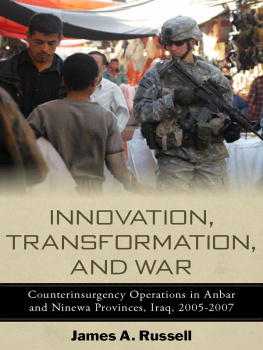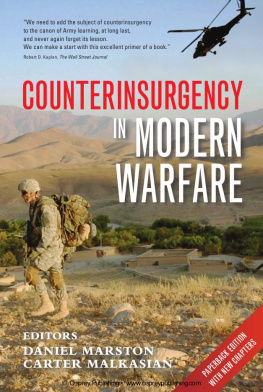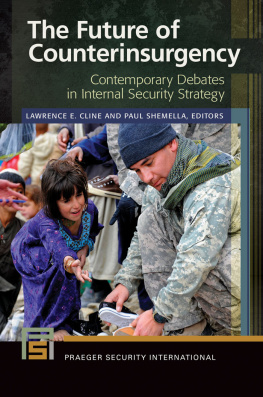INNOVATION, TRANSFORMATION, AND WAR
Counterinsurgency operations in anbar and ninewa, Iraq, 20052007
JAMES A. RUSSELL
STANFORD SECURITY STUDIES
An Imprint of Stanford University Press
Stanford, California
Stanford University Press
Stanford, California
2011 by the Board of Trustees of the Leland Stanford Junior University.
All rights reserved.
No part of this book may be reproduced or transmitted in any form or by any means, electronic or mechanical, including photocopying and recording, or in any information storage or retrieval system without the prior written permission of Stanford University Press.
Printed in the United States of America on acid-free, archival-quality paper
Library of Congress Cataloging-in-Publication Data
Russell, James A. (James Avery).
Innovation, transformation, and war : counterinsurgency operations in Anbar and Ninewa, Iraq, 20052007 / James A. Russell
p. cm.
Includes bibliographical references and index.
ISBN 978-0-8047-7309-6 (cloth : alk. paper)
ISBN 978-0-8047-7310-2 (pbk. : alk. paper)
1. Social CounterinsurgencyIraqAnbar (Province). 2. CounterinsurgencyIraqNinaw. 3. United StatesArmed ForcesIraq. 4. Tactics. 5. Iraq War, 2003. I. Title.
ds79.764.a63r87 2011
956.7044'342dc22 2010030489
Typeset at Stanford University Press in 10/14 Minion
Special discounts for bulk quantities of Stanford Security Studies are available to corporations, professional associations, and other organizations. For details and discount information, contact the special sales department of Stanford University Press.
Tel: (650) 736-1782, Fax: (650) 736-1784
E-book ISBN: 978-0-8047-7748-3
ACKNOWLEDGMENTS
I strongly opposed the Bush administrations decision to invade Iraq and still believe that the invasion represented a strategic blunder from which the United States may never fully recover. I had a deep sense of foreboding in the spring of 2001, when, as a civil servant working on Persian Gulf regional policy at the Defense Department, I watched a new caste of political appointees arrive in the departments policy secretariat. During the 1990s, I had worked as a civilian for Republican and Democratic administrations in the Defense Department and had no problems supporting the regional policy of either party. That changed after the election of 2000, when the civilian policy secretariat became stuffed with right-wing ideologues. Many of these appointees had strong opinions about what to do in the Gulfopinions that I thought were dangerously misguided. As the Iraq country director from 1996 to 1998 in the policy secretariat, I had directly participated in operationalizing the policy of containment that in many ways was deeply unsatisfying but which drew upon a successful strategic template that had successfully protected and furthered Americas global interests for over half a century. Today the policy of containment looks like a bargain when measured against the human and monetary costs associated with the U.S. invasion and occupation of Iraq.
More than a decade of working on Gulf-related security policy had induced in me a certain caution before the war about believing the obviously facile claims of supposed experts who minimized the military challenges that awaited us in Iraq. By 2004 and 2005, veterans of the Iraq war began appearing in my classrooms in the Department of National Security Affairs at the Naval Postgraduate School, where I had successfully decamped to in the summer of 2001. The accounts from my students seemed only to confirm what looked like an unfolding strategic debacle in which incompetence at the highest reaches of our national command authority had placed our men and women in uniform in an extremely difficult military situation.
In 2006, I decided to write a book about their situation. My then neighbor and colleague Professor Harold Trinkunas wandered into my office one day after learning of my plans and urged me to think about writing the book in conjunction with getting a Ph.D. With the help of my good friend Wyn Bowen, I subsequently entered the doctoral program in War Studies at Kings College, University of London. During the development of my dissertation research, Wyn linked me up with Professor Theo Farrell, who subsequently provided invaluable guidance and support as I developed the ideas of military innovation presented in this book.
I started out thinking I would be writing about the U.S. military failure in Iraq. That changed after being invited by Tom Travis and Ted Cavin to the Joint Center for Operational Analysis at the Joint Forces Command in late 2006. During the visit, I heard a presentation by Kelly Musick (a JCOA analyst) about the emergence of so-called counterinsurgency best practices by U.S. forces conducting military operations in Anbar Province during the summer and fall of 2006. The presentation came as press reporting suggested that local security had greatly improved in Anbar with the turning of tribal leaders against Al Qaeda in Iraq, or AQI, as it was then called. I decided to write a book that attempted to document and explain the emergence of these best practices. This book tells part of the story about how American ground forces fought the insurgents in 2005 and 2006 and tries to chronicle the process of adaptation and innovation exhibited by the units covered in these pages.
The JFCOM analysts were surprised at the emergence of these best practices in 2006as was I. Up until this period, U.S. military tactics seemed focused on conventionally oriented military operations, and our ground forces did not seem to be adapting to the insurgency inside Iraq that had gathered momentum throughout 2004 and 2005. Ironically, by late 2006, just as American units in Anbar were mastering counterinsurgency tactics and full-spectrum operations, it became clear that the Bush administration had lost confidence in its military leaders in Iraq. During late 2006, as we were defeating the Sunni insurgency in Anbar, the Bush administration developed a series of policy options that later resulted in the decision to increase the number of troops in the spring of 2007. Many books document what happened next: the promulgation of new joint counterinsurgency doctrine in December 2006, the increase in troop numbers, and the appointment of General David Petraeus as senior military commander in Iraq are widely seen as turning the tide on the battlefield against the insurgents. This book has little to add to that story and instead focuses on tactical-level battlefield operations before the surge, as brigade and company commanders struggled to adapt their balky organizational structures to the demands of fighting an insurgency. The story that emerges in these pages suggests that the established popular narrative of what happened to the U.S. military in Iraq is much more complex than generally believed. Evidence from the cases examined here suggests that adaptation and innovation in the field led the Defense Departments rear-echelon efforts to reorient the organizational capacities of American ground forces toward irregular warfare and counterinsurgency.
Many friends and colleagues helped me along the way. Colleagues in the Department of National Security Affairs at the Naval Postgraduate School provided moral and intellectual support as I slogged my way through the research. I particularly thank Daniel Moran, Don Abenheim, Doug Porch, and Jim Wirtz for their friendship and support. I particularly benefited from an ongoing twoyear conversation with my good friend and colleague Daniel Moran about the many strategic and military issues addressed in these pages. It is certainly the case that his brilliance and insightful analysis helped me try to organize my own thinking on the complicated issues covered in this book. I also found willing and supportive help from the units that I focused on in this research. Nick Marano, Dan Zappa, V. J. Tedesco, Charles Webster, Michael Shields, Mark Freitag, Sean MacFarland, Scott Wuestner, Bill Keyes, William Jurney, Rick Somers, Matt Albertus, Dale Alford, Ed Matthaidess, John Gronski and others were of great assistance in helping me to understand the intricacies of tactical-level operations conducted by their units in Iraq. I should also mention a group of NPS students that participated in a series of seminars I taught in 2007 and 2008 as I refined my own thinking on military innovation. As always in these classes, I learned as much from my students as they did from me and the course readings. Ray Mattox, Pete Rodgers, Bobby Davis, Daniel Hancock, Doug Thies, Kyle Phillips, Brad Fultz, Ferdinand Hafner, Todd Anderson, Bryan Wilson, Dennis Faulkner, Chris Stelle, Bill Duggan, Mark Munson, and Jason Howk all helped to enliven classroom discussions about the issues presented in this book. Barry Zellen also provided invaluable editorial assistance in the preparation of the manuscript.







